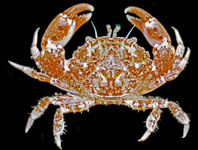Abstract
Descriptions and images of character states are provided of the second instar larvae of 16 species of Haplothrips. Specimens used are from Poland and surrounding countries, and an identification key is presented. The most important qualitative features concern colour, sclerotization and cuticular sculpture of some body parts, spiracle structure, setal lengths and type of setal apices.
References
Crespi, B.J. (1986) Territoriality and fighting in a colonial thrips, Hoplothrips pedicularius, and sexual dimorphism in Thysanoptera. Ecological Entomology, 11, 119–130.
https://doi.org/10.1111/j.1365-2311.1986.tb00286.x
Crespi, B.J. (1988) Adaptation, compromise and constraint: the development, morphometrics and behavioral basis of a fighter-flier polymorphism in male Hoplothrips karnyi. Behavioral Ecology and Sociobiology, 23, 93–104.
https://doi.org/10.1007/BF00299892
Fedor, P., Pena-Mendez, E.M., Kucharczyk, H., Vanhara, J. & Havel, J. (2014) Artificial neural networks in prompt and reliable identification of Thrips fuscipennis and T. sambuci (Thysanoptera: Thripidae): from taxonomy to phytosanitary problems. Turkish Journal of Agriculture and Forestry, 38, 111–124.
https://doi.org/10.3906/tar-1305-8
Kobro, S. & Rafoss, T. (2001) Diagnostic characters of the larvae of some Hoplothrips species (Thysanoptera: Tubulifera) in Norway. European Journal of Entomology, 98 (4), 543–546.
https://doi.org/10.14411/eje.2001.068
Kucharczyk, H. (2007) Wciornastki (Thysanoptera). In: Bogdanowicz, W., Chudzicka E., Pilipiuk, I. & Skibińska, E. (Eds.), Fauna Polski. Vol. II. Charakterystyka i lista gatunków. Muzeum i Instytut Zoologii PAN, Warszawa, pp. 391–398. [in Polish]
Kucharczyk, H. (2010) Comparative morphology of the second larval instar of the Thrips genus species (Thysanoptera: Thripidae) occurring in Poland. Mantis Publishing Company, Olsztyn, 152 pp.
Kucharczyk, H., Kucharczyk, M. & Czepiel-Mil, K. (2017) Preliminary studies on the sex dimorphism in the second stage of larva in Phlaeothripidae on the basis of Hoplothrips pedicularius (Haliday 1836). Abstracts of 5th Palearctic Symposium on Thysanoptera, Poland, Cracow, 26–29 August 2017, 31–32.
Minaei, K., Azemayeshfard, P. & Mound, L.A. (2007) The southern Palearctic genus Neoheegeria (Thysanoptera: Phlaeothripidae): redefinition and key to species. Tijdschrift voor Entomologie, 150, 55–64.
https://doi.org/10.1163/22119434-900000212
Minaei, K. & Mound, L.A. (2008) The Thysanoptera Haplothripini (Insecta: Phlaeothripidae) of Iran. Journal of Natural History, 42 (41–42), 2617–2658.
https://doi.org/10.1080/00222930802354159
Minaei, K. & Mound, L.A. (2010) Taxonomic problems in character state interpretation: variation in the wheat thrips Haplothrips tritici (Kurdjumov) (Thysanoptera, Phlaeothripidae) in Iran. Deutsche entomologische Zeitung, 57 (2), 233–241.
https://doi.org/10.1002/mmnd.201000020
Minaei, K & Mound, L.A. (2014) New synonymy in the wheat thrips, Haplothrips tritici (Thysanoptera: Phlaeothripidae). Zootaxa, 3802 (4), 596–599.
https://doi.org/10.11646/zootaxa.3802.4.9
Mound, L.A. (2005a) Thysanoptera: Diversity and Interactions. Annual Review of Entomology, 50, 247–269.
https://doi.org/10.1146/annurev.ento.49.061802.123318
Mound, L.A. (2005b) Fighting, flight and fecundity: behavioural determinants of Thysanoptera structural diversity. In: Ananthakrishnan, T.N. & Whitman, D. (Eds.), Insects and phenotypic plasticity. Science Publishers Inc., Enfield, New Hampshire, pp. 81–105.
Mound, L.A. & Kibby, G. (1998) Thysanoptera, an identification guide. 2nd Edition. C.A.B. International.Wallingford, Oxon, 70 pp.
Mound, L.A. & Minaei, K. (2007) Australian thrips of the Haplothrips lineage (Insecta: Thysanoptera). Journal of Natural History, 41 (45–48), 2919–2978.
https://doi.org/10.1080/00222930701783219
Pitkin, B.R. (1976) A revision of the Indian species of Haplothrips and related genera (Thysanoptera: Phlaeothripidae). Bulletin of the British Museum (Natural History), Entomology, 34, 223–280.
Priesner, H. (1926) Die Jugendstadien der Malaysischen Thysanopteren. Treubia, Supplement 8, 1–264.
Priesner, H. (1964a) A monograph of the Thysanoptera of the Egyptian deserts. Publications de l’Institut du Désert d’Egypt, 13, 1–549.
Priesner, H. (1964b) Ordnung Thysanoptera (Fransenflügler, Thripse), in Franz H. (ed.). Bestimmungsbücher der Bodenfauna Europas, 2, 1–242.
Stanisławek, K. & Kucharczyk, H. (2012) Comparative morphology of the second larval instar of Haplothrips setiger Priesner 1921, H. jasionis Priesner 1950 and H. statices Haliday 1836 (Thysanoptera, Phlaeothripidae). Acta Phytopathologica et Entomologica Hungarica, 47 (1), 141–150.
https://doi.org/10.1556/APhyt.47.2012.1.18
Schliephake, G. & Klimt, K. (1979) Thysanoptera, Fransenflügler. Die Tierwelt Deutschlands, 66, 1–477.
Szmuryło, J. (2013) Hoplothrips pedicularius (Haliday 1836) (Thysanoptera, Tubulifera)—biology and morphology of developmental stages. Manuscript in Department of Zoology and Nature Protection MC-S University, Lublin, 49 pp. [in Polish]
ThripsWiki (2020) Providing information on the World's thrips. Available from: http://thrips.info/wiki/ (accessed 24 April 2020)
Vierbergen, G.B., Kucharczyk, H. & Kirk, W.D.J. (2010) A key to the second instar larvae of the Thripidae of the Western Palaearctic region (Thysanoptera). Tijdschrift voor Entomologie, 153, 99–160.
https://doi.org/10.1163/22119434-900000294
Zawirska, I. (1993) Beitrag zum Vorkommen und zur Morphologie von Haplothrips cerealis Priesner und H. tritici Kurdjumov (Insecta: Tubulifera: Phlaeothripidae) in Polen. Zoology, Journal of Pure and Applied Biology, 4, 399–407.


